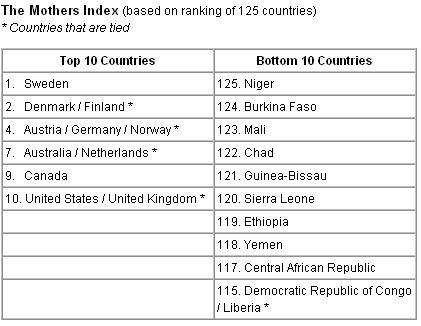From rxpgnews.com
The Best and Worst Countries to Be a Mother
By Save the Children
May 10, 2006, 02:58
Save the Children, a U.S. - based independent global humanitarian organization, released today its annual Mothers� Index that ranks the best - and worst - places to be a mother and a child. The Index, highlighted in the organization�s State of the World�s Mothers 2006 report, ranks the status of mothers and children in 125 countries based on 10 indicators pertaining to health and education.
Save the Children�s State of the World�s Mothers 2006 report takes a closer look at the inextricable link between the health and survival of mothers and babies, narrowing in on simple, affordable solutions that can help save 3 million of the 4 million newborns who die every year.
Scandinavian countries sweep the top rankings of the best places to be a mother, while countries in sub-Saharan Africa dominate the bottom tier. The United States ties for 10th place with the United Kingdom.
"The Mothers� Index illustrates the direct line between the status of mothers and the status of their children," said Charles MacCormack, President and CEO of Save the Children. �In countries where mothers do well, children do well; in countries where mothers fare poorly, children fare poorly. If we are to improve the quality of life for children, we must start by investing in the health and well-being of their mothers.�
Zeroing in on only those indicators that capture children�s well-being, Somalia finishes in last place. More than 1 out of every 7 children in Somalia die before his or her first birthday, 71 percent of the population has no access to safe drinking water, and 17 percent of children are suffering from malnutrition. The situation for Somali mothers is equally dismal: 1 in 10 women dies in childbirth; 75 percent of all newborns are delivered without skilled health personnel and 78 percent of pregnant women have anemia.
�Life is not easy for moms and children in the bottom-ranked countries. Most have never been to school. Mothers are lucky to survive childbirth, and their babies fortunate to survive the first month, yet alone the first year of life,� said MacCormack. �But the good news is that we know what it takes to help these moms and children survive and thrive.�
�Humanitarian organizations like Save the Children are working in partnership with communities and governments to provide proven programs that benefit mothers and children in developing countries. Save the Children�s 70-plus years of experience on the ground have shown us that increasing access to education and child and maternal health�including family planning�are critical to the well-being of children and their mothers,� he said.
The Mothers' Index identifies female education, presence of a skilled attendant at birth and access to, and use of, family planning services, as the three areas most strongly associated with child survival and well-being.
 |
According to the report, women who are educated are more likely to postpone marriage and early childbirth, seek health care for themselves and their families, and encourage all of their children, including girls, to go to school. As contraceptive use rises and mothers are able to space their births at healthy intervals, deaths among mothers and children decline. For example, in the United States, 71 percent of women use modern birth control, 1 in 2,500 mothers dies in childbirth and 7 out of 1,000 infants do not live to see their first birthday. Compare this to Mali, where 6 percent of women use birth control, 1 in 10 mothers dies in childbirth, and 1 in 8 infants dies before reaching age 1.
The Mothers' Index exposes an enormous disparity between the highest- and lowest-scoring countries and underscores an urgent need to address this divide. For instance, in Sweden, which tops the list, nearly all women are literate. In contrast, only 34 percent of Ethiopian women are literate. And a mother in Ethiopia is 37 times more likely to see her child die in the first year of life than a mother in Sweden.
The report highlighted that compared to a mother in the top 10 countries, a mother in the bottom 10 countries is 28 times more likely to see her child die in the first year of life and over 750 times more likely to die herself in pregnancy or childbirth. In the bottom 10 countries, nearly 1 out of 3 children is not enrolled in school and only 1 out of 4 adult women is literate. In the top 10 countries, virtually all children go to school and all women are literate. Skilled health personnel attend fewer than 15 percent of births in Afghanistan, Bangladesh, Ethiopia and Nepal. Fewer than 5 percent of women use modern contraception in Chad, Guinea, Guinea-Bissau, Democratic Republic of the Congo, Niger, Rwanda and Sierra Leone.
All rights reserved by www.rxpgnews.com
|
|
